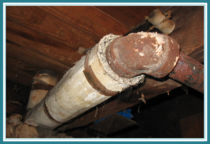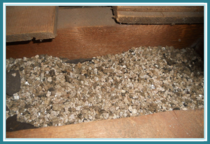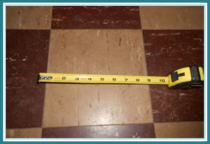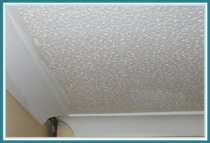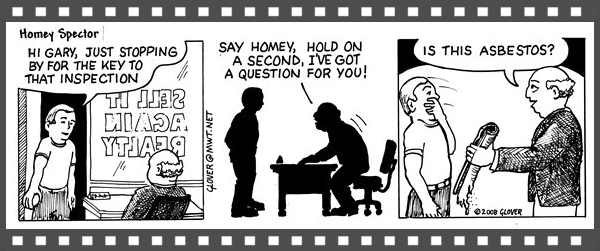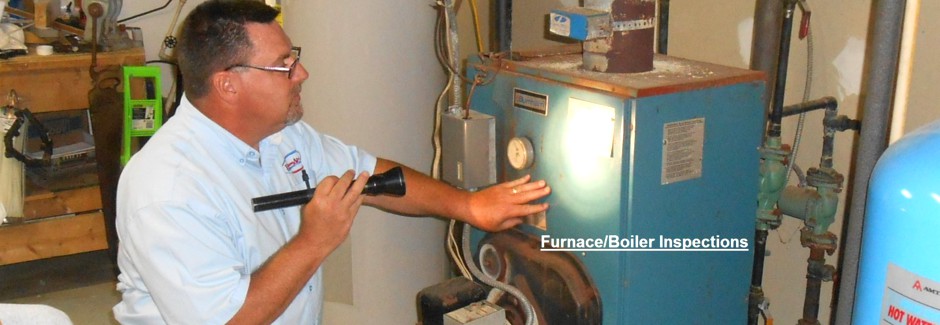
★ Asbestos in the Home ★
What is Asbestos?
The risk of lung cancer and mesothelioma increase with the number of fibers inhaled. The risk of lung cancer from inhaling asbestos fibers is also greater if you smoke. People who get asbestosis have usually been exposed to high levels of asbestos for a long time. The symptoms of these diseases do not usually appear until about 20 to 30 years after the first exposure to asbestos.
Most people exposed to small amounts of asbestos, as we all are in our daily lives, do not develop these health problems. However, if disturbed, asbestos material may release asbestos fibers, which can be inhaled into the lungs. The fibers can remain there for a long time, increasing the risk of disease. Asbestos material that would crumble easily if handled, or that has been sawed, scraped, or sanded into a powder, is more likely to create a health hazard.
-
steam pipes, boilers and furnace ducts insulated with an asbestos blanket or asbestos paper tape. These materials may release asbestos fibers if damaged, repaired, or removed improperly;
-
resilient floor tiles (vinyl asbestos, asphalt and rubber), the backing on vinyl sheet flooring, and adhesives used for installing floor tile. Sanding tiles can release fibers, and so may scraping or sanding the backing of sheet flooring during removal;
-
cement sheet, millboard and paper used as insulation around furnaces and wood-burning stoves. Repairing or removing appliances may release asbestos fibers, and so may cutting, tearing, sanding, drilling, or sawing insulation;
-
door gaskets in furnaces, wood stoves and coal stoves. Worn seals can release asbestos fibers during use;
-
soundproofing or decorative material sprayed on walls and ceilings. Loose, crumbly or water-damaged material may release fibers, and so will sanding, drilling or scraping the material;
-
patching and joint compounds for walls and ceilings, and textured paints. Sanding, scraping, or drilling these surfaces may release asbestos fibers;
-
asbestos cement roofing, shingles and siding. These products are not likely to release asbestos fibers unless sawed, dilled or cut;
-
artificial ashes and embers sold for use in gas-fired fireplaces, and other older household products, such as fireproof gloves, stove-top pads, ironing board covers and certain hairdryers; and
-
automobile brake pads and linings, clutch facings and gaskets.
- Some roofing and siding shingles are made of asbestos cement.
- Houses built between 1930 and 1950 may have asbestos as insulation.
- Asbestos may be present in textured paint and in patching compounds used on wall and ceiling joints. Their use was banned in 1977.
- Artificial ashes and embers sold for use in gas-fired fireplaces may contain asbestos.
- Older products, such as stove-top pads, may have some asbestos compounds.
- Walls and floors around wood-burning stoves may be protected with asbestos paper, millboard or cement sheets.
- Asbestos is found in some vinyl floor tiles and the backing on vinyl sheet flooring and adhesives.
- Hot water and steam pipes in older houses may be coated with an asbestos material or covered with an asbestos blanket or tape.
- Oil and coal furnaces and door gaskets may have asbestos insulation.
What Should Be Done About Asbestos in the Home?
-
Make sure no one else is in the room when sampling is done.
-
Wear disposable gloves or wash hands after sampling.
-
Shut down any heating or cooling systems to minimize the spread of any released fibers.
-
Do not disturb the material any more than is needed to take a small sample.
-
Place a plastic sheet on the floor below the area to be sampled.
-
Wet the material using a fine mist of water containing a few drops of detergent before taking the sample. The water/detergent mist will reduce the release of asbestos fibers.
-
Carefully cut a piece from the entire depth of the material using a small knife, corer or other sharp object. Place the small piece into a clean container (a 35-mm film canister, small glass or plastic vial, or high-quality resealable plastic bag).
-
Tightly seal the container after the sample is in it.
-
Carefully dispose of the plastic sheet. Use a damp paper towel to clean up any material on the outside of the container or around the area sampled. Dispose of asbestos materials according to state and local procedures.
-
Label the container with an identification number and clearly state when and where the sample was taken.
-
Patch the sampled area with the smallest possible piece of duct tape to prevent fiber release.
-
Send the sample to an asbestos analysis laboratory accredited by the National Voluntary Laboratory Accreditation Program (NVLAP) at the National Institute of Standards and Technology (NIST). Your state or local health department may also be able to help.
Before undertaking minor repairs, be sure to follow all the precautions described previously for sampling asbestos material. Always wet the asbestos material using a fine mist of water containing a few drops of detergent. Commercial products designed to fill holes and seal damaged areas are available. Small areas of material, such as pipe insulation, can be covered by wrapping a special fabric, such as re-wettable glass cloth, around it. These products are available from stores (listed in the telephone directory under "Safety Equipment and Clothing") which specialize in asbestos materials and safety items.
If you have a problem that requires the services of asbestos professionals, check their credentials carefully. Hire professionals who are trained, experienced, reputable and accredited -- especially if accreditation is required by state or local laws. Before hiring a professional, ask for references from previous clients. Find out if they were satisfied. Ask whether the professional has handled similar situations. Get cost estimates from several professionals, as the charges for these services can vary.
Though private homes are usually not covered by the asbestos regulations that apply to schools and public buildings, professionals should still use procedures described in federal or state-approved training. Homeowners should be alert to the chance of misleading claims by asbestos consultants and contractors. There have been reports of firms incorrectly claiming that asbestos materials in homes must be replaced. In other cases, firms have encouraged unnecessary removal or performed it improperly. Unnecessary removal is a waste of money. Improper removal may actually increase the health risks to you and your family. To guard against this, know what services are available and what procedures and precautions are needed to do the job properly.
In addition to general asbestos contractors, you may select a roofing, flooring or plumbing contractor trained to handle asbestos when it is necessary to remove and replace roofing, flooring, siding or asbestos-cement pipe that is part of a water system. Normally, roofing and flooring contractors are exempt from state and local licensing requirements because they do not perform any other asbestos-correction work.
-
Make sure that the inspection will include a complete visual examination, and the careful collection and lab analysis of samples. If asbestos is present, the inspector should provide a written evaluation describing its location and extent of damage, and give recommendations for correction or prevention.
-
Make sure an inspecting firm makes frequent site visits if it is hired to assure that a contractor follows proper procedures and requirements. The inspector may recommend and perform checks after the correction to assure that the area has been properly cleaned.
If you hire a corrective-action contractor:
-
Check with your local air pollution control board, the local agency responsible for worker safety, and the Better Business Bureau. Ask if the firm has had any safety violations. Find out if there are legal actions filed against it.
-
Insist that the contractor use the proper equipment to do the job. The workers must wear approved respirators, gloves and other protective clothing.
-
Before work begins, get a written contract specifying the work plan, cleanup, and the applicable federal, state and local regulations which the contractor must follow (such as notification requirements and asbestos disposal procedures). Contact your state and local health departments, EPA regional office, and the Occupational Safety and Health Administration's regional office to find out what the regulations are. Be sure the contractor follows local asbestos removal and disposal laws. At the end of the job, get written assurance from the contractor that all procedures have been followed.
-
Assure that the contractor avoids spreading or tracking asbestos dust into other areas of your home. They should seal off the work area from the rest of the house using plastic sheeting and duct tape, and also turn off the heating and air conditioning system. For some repairs, such as pipe insulation removal, plastic bags may be adequate. They must be sealed with tape and properly disposed of when the job is complete.
-
Make sure the work site is clearly marked as a hazardous area. Do not allow household members or pets into the area until work is completed.
-
Insist that the contractor apply a wetting agent to the asbestos material with a hand sprayer that creates a fine mist before removal. Wet fibers do not float in the air as easily as dry fibers and will be easier to clean up.
-
Make sure the contractor does not break removed material into smaller pieces. This could release asbestos fibers into the air. Pipe insulation was usually installed in pre-formed blocks and should be removed in complete pieces.
-
Upon completion, assure that the contractor cleans the area well with wet mops, wet rags, sponges and/or HEPA (high-efficiency particulate air) vacuum cleaners. A regular vacuum cleaner must never be used. Wetting helps reduce the chance of spreading asbestos fibers in the air. All asbestos materials and disposable equipment and clothing used in the job must be placed in sealed, leakproof, and labeled plastic bags. The work site should be visually free of dust and debris. Air monitoring (to make sure there is no increase of asbestos fibers in the air) may be necessary to assure that the contractor's job is done properly. This should be done by someone not connected with the contractor.
Do not dust, sweep or vacuum debris that may contain asbestos. These actions will disturb tiny asbestos fibers and may release them into the air. Remove dust by wet-mopping or with a special HEPA vacuum cleaner used by trained asbestos contractors.
From Asbestos - Int'l Association of Certified Home Inspectors (InterNACHI) http://www.nachi.org/asbestos.htm#ixzz2Wk030LRl
Please Call ☎ (518) 505-8305 To Schedule Your Home Inspection!
Serving Albany, Columbia, Fulton, Greene, Montgomery, Rensselaer, Saratoga, Schenectady, Schoharie & Washington Counties

